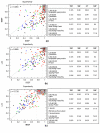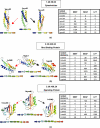Structural footprinting in protein structure comparison: the impact of structural fragments
- PMID: 17688700
- PMCID: PMC2082327
- DOI: 10.1186/1472-6807-7-53
Structural footprinting in protein structure comparison: the impact of structural fragments
Abstract
Background: One approach for speeding-up protein structure comparison is the projection approach, where a protein structure is mapped to a high-dimensional vector and structural similarity is approximated by distance between the corresponding vectors. Structural footprinting methods are projection methods that employ the same general technique to produce the mapping: first select a representative set of structural fragments as models and then map a protein structure to a vector in which each dimension corresponds to a particular model and "counts" the number of times the model appears in the structure. The main difference between any two structural footprinting methods is in the set of models they use; in fact a large number of methods can be generated by varying the type of structural fragments used and the amount of detail in their representation. How do these choices affect the ability of the method to detect various types of structural similarity?
Results: To answer this question we benchmarked three structural footprinting methods that vary significantly in their selection of models against the CATH database. In the first set of experiments we compared the methods' ability to detect structural similarity characteristic of evolutionarily related structures, i.e., structures within the same CATH superfamily. In the second set of experiments we tested the methods' agreement with the boundaries imposed by classification groups at the Class, Architecture, and Fold levels of the CATH hierarchy.
Conclusion: In both experiments we found that the method which uses secondary structure information has the best performance on average, but no one method performs consistently the best across all groups at a given classification level. We also found that combining the methods' outputs significantly improves the performance. Moreover, our new techniques to measure and visualize the methods' agreement with the CATH hierarchy, including the threshholded affinity graph, are useful beyond this work. In particular, they can be used to expose a similar composition of different classification groups in terms of structural fragments used by the method and thus provide an alternative demonstration of the continuous nature of the protein structure universe.
Figures






Similar articles
-
Secondary structure spatial conformation footprint: a novel method for fast protein structure comparison and classification.BMC Struct Biol. 2006 Jun 8;6:12. doi: 10.1186/1472-6807-6-12. BMC Struct Biol. 2006. PMID: 16762072 Free PMC article.
-
Quantifying structure-function uncertainty: a graph theoretical exploration into the origins and limitations of protein annotation.J Mol Biol. 2004 Apr 2;337(4):933-49. doi: 10.1016/j.jmb.2004.02.009. J Mol Biol. 2004. PMID: 15033362
-
Structural diversity of domain superfamilies in the CATH database.J Mol Biol. 2006 Jul 14;360(3):725-41. doi: 10.1016/j.jmb.2006.05.035. Epub 2006 Jun 2. J Mol Biol. 2006. PMID: 16780872
-
Assessing strategies for improved superfamily recognition.Protein Sci. 2005 Jul;14(7):1800-10. doi: 10.1110/ps.041056105. Epub 2005 Jun 3. Protein Sci. 2005. PMID: 15937274 Free PMC article.
-
Structural alphabets for protein structure classification: a comparison study.J Mol Biol. 2009 Mar 27;387(2):431-50. doi: 10.1016/j.jmb.2008.12.044. Epub 2008 Dec 25. J Mol Biol. 2009. PMID: 19135454 Free PMC article.
Cited by
-
Assessment of CASP10 contact-assisted predictions.Proteins. 2014 Feb;82 Suppl 2(Suppl 2):84-97. doi: 10.1002/prot.24367. Epub 2013 Oct 17. Proteins. 2014. PMID: 23873510 Free PMC article.
-
Progress in the PRIDE technique for rapidly comparing protein three-dimensional structures.BMC Res Notes. 2008 Jul 11;1:44. doi: 10.1186/1756-0500-1-44. BMC Res Notes. 2008. PMID: 18710497 Free PMC article.
-
A method of protein model classification and retrieval using bag-of-visual-features.Comput Math Methods Med. 2014;2014:269394. doi: 10.1155/2014/269394. Epub 2014 Sep 1. Comput Math Methods Med. 2014. PMID: 25258644 Free PMC article.
References
Publication types
MeSH terms
Grants and funding
LinkOut - more resources
Full Text Sources
Other Literature Sources

